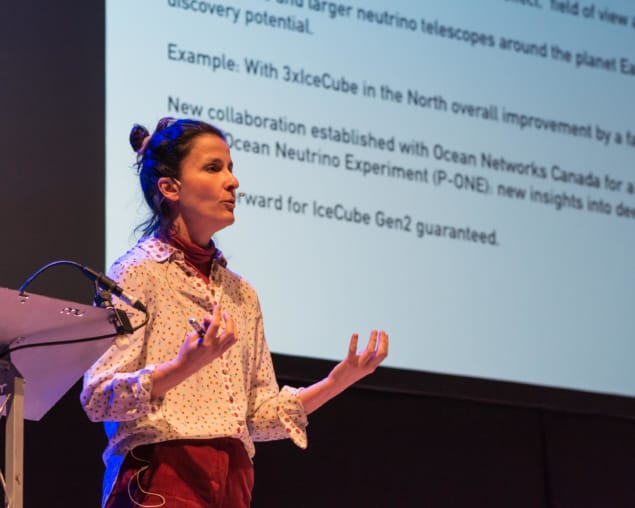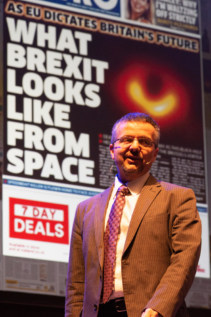
Growing up in coastal Somerset, UK, once a year I used to watch from the living-room window with incredulity as American muscle cars and pick-up trucks roared past our house. This procession of Fords, Dodges and Chryslers were filled to the brim with people dressed up in their finest Deep South regalia – on their way to the windswept Brean Country and Western Festival.
The name of the conference I find myself attending kindles images from those bizarre childhood memories. But luckily, attendees at TEXAS 2019 are not sporting cowboy boots or questionable American Indian costumes. They are physicists from all over the world, meeting at the beautiful Guildhall venue in the heart of Portsmouth, UK, to hear about and discuss the latest discoveries in fields related to the relativistic theory of gravitation and cosmology. TEXAS 2019 is hosted by the University of Portsmouth’s Institute of Cosmology and Gravitation.
Though the first day is not yet over as I write – with a number of in-depth parallel sessions still ongoing – there has already been plenty for conferencegoers to talk about. For instance, the morning’s plenary talks began with a bang as University of Arizona’s Dimitrios Psaltis got straight into the most talked about news from astrophysics this year – the first-ever picture of a black hole, which last week bagged the Physics World Breakthrough of the Year award for 2019.

Psaltis was one of the lead scientists behind the image, which was taken by the Event Horizon Telescope (EHT), an international collaboration involving over 200 astronomers and eight radio dishes in six different locations across the globe.
Somehow Psaltis adroitly managed to condense over 40 years of black hole imaging theory, the 10-year history of the EHT, and how black hole imaging might offer tests for some of the big outstanding mysteries in relativity, into just 40 minutes. And he still managed to provide fascinating and often amusing insights: “The data [from EHT] is so immense that we cannot transfer it over the Internet, so we literally put it in crates and FedEx them,” he revealed. “One of those crates when we opened it in Bonn, we found fabric – and there was a factory in Germany that opened their crates expecting fabric and found hard drives.”
The data [from EHT] is so immense that we cannot transfer it over the Internet, so we literally put it in crates and FedEx them.
Dimitrios Psaltis
The black-hole image Psaltis and the EHT team took was of a supermassive black hole residing at the heart of nearby (cosmologically speaking) giant elliptical galaxy M87. It was apt then that the following speaker – the University of Cambridge’s Chris Reynolds – continued the supermassive black hole theme by explaining how they are not only the “ultimate laboratory for studying relativistic gravity,” but may also offer hints towards building a fundamental theory of how the universe works beyond the Standard Model of particle physics.
The Standard Model is one of the great triumphs of 20th-century physics, as precise and well tested as relativity. Yet though it accurately explains everything we see – matter – it does not explain 95% of the theorised universe. Hypothesised uncharged particles called axions are candidates for about 27% of the missing universe: dark matter. But they have never been observed.
One way Reynolds explained how supermassive black holes are already helping to go beyond the Standard Model and illuminate axions’ existence (or not) is by spinning. “If axions exist and are very low mass, they can actually form gravitational atoms with black holes… and there will be a wholesale zapping of the black hole spin energy that will then get radiated away,” he said. “So the very observation of spin black holes in nature is constraining these axions.”
After a fascinating and detailed talk by Elena Gallo from the University of Michigan on models and new evidence suggesting jets – extremely powerful streams of particles emanating from active galactic nuclei (AGNs) – could be powered by black hole spin, the last plenary of the day was delivered by Elisa Resconi.
Resconi is a neutrino physicist from Technical University, Munich. As part of the IceCube Collaboration – the team behind the IceCube South Pole neutrino observatory – she was involved in another astrophysics breakthrough that made the headlines when in 2018 the team announced they had, for the first time, pinpointed a cosmological source for the neutrinos they had detected. Since the catchily named TXS 0506+056a blazar – an AGN with a relativistic jet pointed towards Earth – was identified as an IceCube neutrino source, Resconi revealed during her talk that the team had identified around 70 high-energy neutrino events they could associate with blazars.

First direct observation of a black hole and its ‘shadow’ is Physics World 2019 Breakthrough of the Year
Though impressive, Resconi thinks astrophysics has only scratched the surface of neutrino astronomy’s usefulness. “The questions that concern neutrinos are: where are the most extreme cosmic accelerators? What are their compositions. How do particles get boosted in relativistic jets? And eventually, is there any exotic physics happening inside these jets?,” she stated. “We need to build more neutrino telescopes and we need to be able to operate them together ‘in plenum’.”
We need to build more neutrino telescopes.
Elisa Resconi
With the black hole-focused first day of talks coming to a close, attendees have a fascinating four more to look forward to, covering a broad range of hot topics. But they (and I) also face a challenge. Given many major astrophysical discoveries have been announced at the biennial TEXAS symposia since 1963, picking which lectures to attend is going to be fraught with difficulty.



